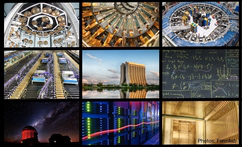NOvA is a long-baseline neutrino oscillation experiment which uses two functionally identical liquid scintillator detectors separated by 810 km. Both detectors are situated 14 mrad off-axis with respect to the NuMI neutrino beam at Fermilab. NOvA is primarily designed to measure the muon (anti)neutrino disappearance and electron (anti)neutrino appearance to constrain the neutrino mass...
Abstract
Neutrino cross sections are an essential component to any neutrino measurement. With the modern neutrino experiments targeting to measure precision parameters, such as those in long-baseline oscillation experiments like NOvA, the need for a detailed understanding of neutrino interactions has become even more important. Among the neutrino-nucleus interactions, Charged Current...
NOvA is a neutrino oscillation experiment that uses Near and Far detectors to measure electron neutrino appearance and muon neutrino disappearance. The classification of neutrino flavour will be helped by the identification of final state particles of the neutrino interaction. So, NOvA has developed a Convolutional neural network (CNN) for single particle classification which employs...
We present the status of the measurement of muon neutrino charged-current cross section with zero mesons in the final state in the NOvA near detector. NOvA is a long-baseline accelerator neutrino experiment at Fermilab whose physics goals include precision neutrino oscillation as well as cross section measurements. The present work aims to produce differential cross section measurements with...
The primary goal of the Muon $g-2$ experiment at Fermilab (E989) is to measure the anomalous magnetic moment of the muon, $a_{\mu}$, to a precision of 140 ppb. This anomaly receives contributions from all sectors of the Standard Model (SM), and beyond, via loop diagrams at the muon-photon vertex. As such, any divergence of $a_{\mu}$ from the SM is indirect evidence of new physics. In April...
The purpose of the Mu2e experiment is to search for the charged lepton flavor violating process muon to electron conversion in the field of a nucleus. A discovery from Mu2e would be a clear sign of physics beyond the standard model. Several cutting edge techniques will be employed in the experiment to improve the current experimental limits by four orders of magnitude. An intense beam of muons...
The muon campus program at Fermilab includes the Mu2e experiment that will search for a charged-lepton flavor violating processes where a negative muon converts into an electron in the field of an aluminum nucleus, improving by four orders of magnitude the search sensitivity reached so far.
Mu2e’s Trigger and Data Acquisition System (TDAQ) uses $\it{otsdaq}$ solution. Developed at Fermilab,...
The Mu2e experiment aims to search for the CLFV neutrinoless, coherent conversion process of muons into electrons, in the field of a nucleus. The goal of our work is to enhance the Offline event display of the experiment, developed using the ROOT based 3-D event visualisation framework called TEve. New features have been added to the existing display and further improvements are underway to...
In this talk, I will give a brief overview of simulating quantum field theories on a quantum computer in the Hamiltonian formalism. Especially, I will discuss the renormalization of such quantum simulations: in order to perform calculations on finite computers, one must discretize the quantum field theories, and perform renormalization which accounts for and removes discretization errors to...
Pulse-level control of variational algorithms can be used to design hardware-efficient ansatzes capable of implementing Quantum Approximate Optimization Algorithms (QAOA) [1]. We study the framework in the context of qudits which are defined as controllable modes on superconducting radio frequency (SRF) 3D cavity-qubit systems. The SRF cavities have long coherence time and can support...
Flavor superposed neutrino states exhibit bipartite and tripartite mode entanglement [1]. In [2], the quantum simulation of bipartite entanglement in the two-neutrino system has been done on an IBM quantum computer. The present work describes the mapping of two and three mode neutrino states to the Poincare sphere using the SU(2) Pauli matrices and SU(3) Gell-Mann matrices, respectively. This...
Experimental system design, or the problem of developing an instrument architecture for an experiment, is a difficult optimization problem due to its high dimensionality, combination of discrete and continuous variables, and the implicit cross dependency of those variables. Conventional methods, such as genetic algorithms, are inefficient due to their ignorance of how specific sub-choices...
The “muon-to-electron conversion” (Mu2e) experiment at Fermilab will search for the Charged Lepton Flavour Violating neutrino-less coherent conversion of a muon into an electron in the field of an aluminum nucleus. The observation of this process would be the unambiguous evidence of physics beyond the Standard Model. Mu2e detectors comprise a straw-tracker, an electromagnetic calorimeter and...
This paper generalizes the quantum amplitude amplification and amplitude estimation algorithms to work with non-boolean oracles. The action of a non-boolean oracle Uφ on an eigenstate |x⟩ is to apply a state-dependent phase-shift φ(x). Unlike boolean oracles, the eigenvalues exp(iφ(x)) of a non-boolean oracle are not restricted to be ±1. Two new oracular algorithms based on such non-boolean...
